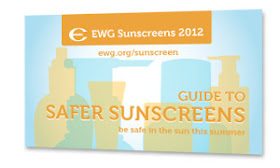Even so, the Environmental Working Group, a consumer advocacy agency, had circulated a petition asking for tougher standards, particularly the banning of sunscreen ingredients that may be carcinogens, affect reproductive organs, or act as toxins to the body. Every year, they publish a guide to sunscreen ingredients, and a list of brands that are deemed the safest as well as those that are labeled “worst offenders.”
You can access their 2012 sunscreen database here and look up your brand.
I’m concerned about the ingredients in many of the products my family and I use, particularly since many chemicals in cosmetic and beauty products have not been tested for safety, especially in combination with others, and because many products contain chemicals known to cause cancer. You can watch a short video titled “The Story of Cosmetics” here to learn more about this. I’ve consulted the EWG’s sunscreen database for two years now, and I signed their petition mentioned above. They plan to continue this work, and I plan to keep signing petitions and using their database until all the products on the shelf are safe.
Whenever I talk to my students about the chemicals in beauty products, they always want to know what brand I use. I urge you to do your own research to find the best products for your family, but I will tell you which sunscreens I use and why. Two of the safest types of sunscreens are the minerals titanium dioxide and zinc oxide. I only consider products with these active ingredients. My other criteria are: natural inactive ingredients and as few ingredients as possible. This year, the only products that meet these criteria are made by W. S. Badger Co. I use Badger SPF 30 Sunscreen For Face & Body 2.9 oz (87 ml)
You may be wondering if these products work. Yes. Like most sunscreens, you need to reapply after 2 hours or spending time in the water. My children are getting good tans this year, but they have not burned. Also, I’ve heard that these products are sold out at a few on-line retailers, so I’m not the only one who thinks they are worth buying. If you can’t find them anywhere, you can try Jason Natural Cosmetics Sunbrellas MINERAL Natural Sunblock, SPF 30 4 oz (113 g)
Sometime soon, I’ll write about which foods can help you increase the SPF factor of your own skin. Back in the days before sunscreen, people relied on a healthy diet, a big hat, and clothing that covered to protect them from the sun. That was before we tore a hole in the protective ozone layer, of course. Also, consider going without sunscreen if you will only be outside ten or fifteen minutes. When exposed to sunlight, your upper body makes vitamin D, and most Americans do not have adequate levels for immune system function and building bones. Some researchers believe that less people would become ill if all of us had proper levels of vitamin D.

No comments:
Post a Comment
Your feedback, reactions, and ideas are appreciated!